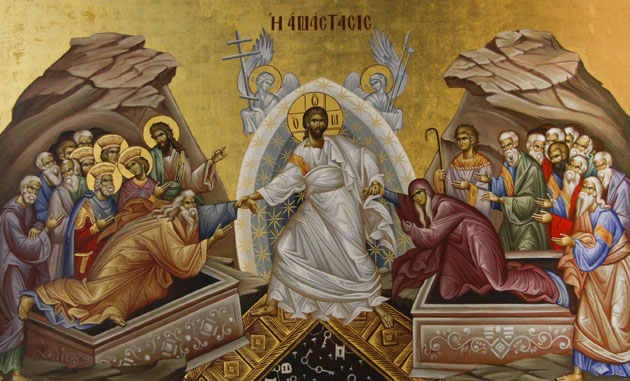Holy Week in the Eastern Orthodox Church is the week that concludes the Great Lent and leads to the celebration of Pascha.
Filled with symbolism, ritual and traditions it is the most important week on the Greek Orthodox calendar and is celebrated throughout Greece, from the largest city to the smallest village. This particular week, in religious services is shrouded with grieving and mourning leading to Easter Sunday, where the rays of the rising sun reveal that Christ Our Savior has resurrected.
Great and Holy Week is the week from the conclusion of
Great Lent on the
Saturday of Lazarus to the celebration of
Pascha. It is emphasized that the services of Holy Week follow the ecclesiastical day, that is from sundown to sundown. Thus Saturday of Lazarus ends at sundown on Saturday.
Holy Monday & Holy Tuesday
The first day of the Holy week reflects upon the last instructions left by Jesus to his disciples. These are remembered in the Great Compline, Matins, Hours, and Liturgy during these days. The Liturgy of the Presanctified Gifts celebrated these days includes readings from Exodus, Job, and Matthew.
The Matins services of the evenings of Palm Sunday, Holy Monday, and Holy Tuesday, anticipating the events of the next day, share a common theme. These Bridegroom Services are derived from the Parable of the Ten Virgins, which calls for preparedness at the Second Coming, for the “thief comes in the middle of the night.” (Matt. 26:1-13) [ Source:orthodoxwiki.org]
Holy Wednesday
Within the past two centuries, Byzantine practice has developed to include the mystery of Holy Unction, which is celebrated on Holy Wednesday, commemorating Christ’s anointing with myrrh. The services appointed by the Typikon for the evening of Holy Wednesday recall that on this day Judas betrayed Christ, which led to the tradition from Apostolic times of fasting on Wednesday throughout the year. It also focuses on the Mystical Supper, which is celebrated in the liturgy of the following day. [ Source:orthodoxwiki.org]
The Mystical Supper
Holy Thursday
Holy Thursday begins with the celebration of vespers and the Divine Liturgy of St. Basil, in representation of the earthly presence of Christ realized at the Last Supper. In the evening, anticipating the Matins of Friday morning, the Holy Passion service of the reading of the Twelve Gospels is conducted. In these readings Christ’s last instructions to his disciples are presented, as well as the prophecy of the drama of the Cross, Christ’s prayer, and his new commandment. [source:orthodoxwiki.org]
Holy Friday
Great and Holy Friday begins with reading of the Royal Hours leading up to Vespers of Friday afternoon, at which time the removal of the Body of Christ from the Cross is commemorated. The priest removes the Body of Christ, the Epitaphios, from the Cross, wraps it in a white cloth and carries it into the altar. In an evening service, called the Lamentations at the Tomb, the priest carries the Epitaphios, the painted or embroidered cloth representation of Christ, from the altar around the church before placing it in the Sepulcher, a bier symbolizing the Tomb of Christ. [source:orthodoxwiki.org]
Holy Saturday
Great and Holy Saturday Vespers and a Divine Liturgy of St. Basil are served, marked with readings of Psalms and Resurrection hymns that tell of Christ’s descent into Hades, celebrated as the “First Resurrection” of Adam and the conquering of Death. It is appointed by the typikon to be celebrated in the afternoon, though it is served in the morning in many places.
This service comes from the ancient liturgical tradition of the Church of Constantinople and was its primary Paschal service. The hymn “Arise O God” from the Psalms was the original primary Paschal hymn before “Christ is risen” came to take its place. Its place as the ancient Constantinopolitan Paschal celebration is what gives the service such a bright and resurrectional character. [source:orthodoxwiki.org]
Pascha
The Resurrection of Christ
Pascha, the Feast of Feasts, celebrations begins just before midnight with the singing of the Odes of Lamentation as the Resurrection Vespers begins with the church in complete darkness. As midnight approaches the priest taking a light from a vigil light within the altar passes the flame to the faithful for their candles while singing “Come ye and receive light from the unwaning life, and, glorify Christ, who arose from the dead.” [source:orthodoxwiki.org]


Leave a comment